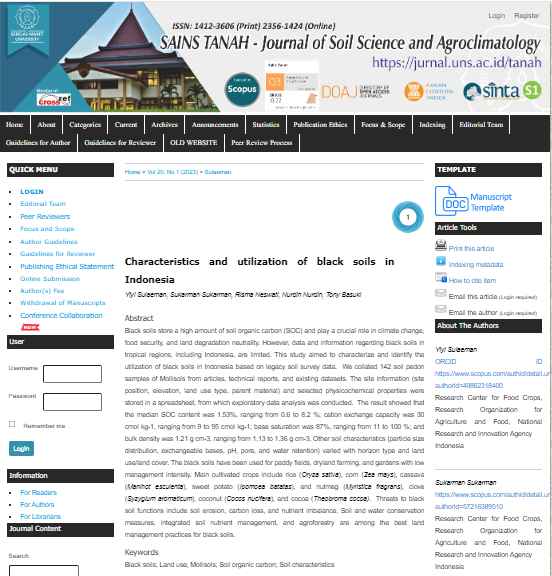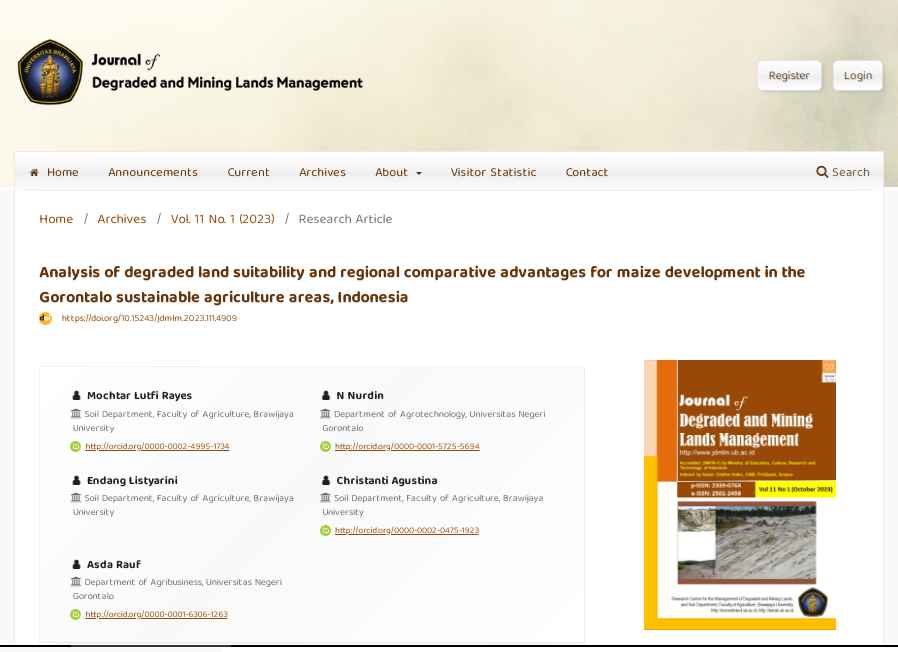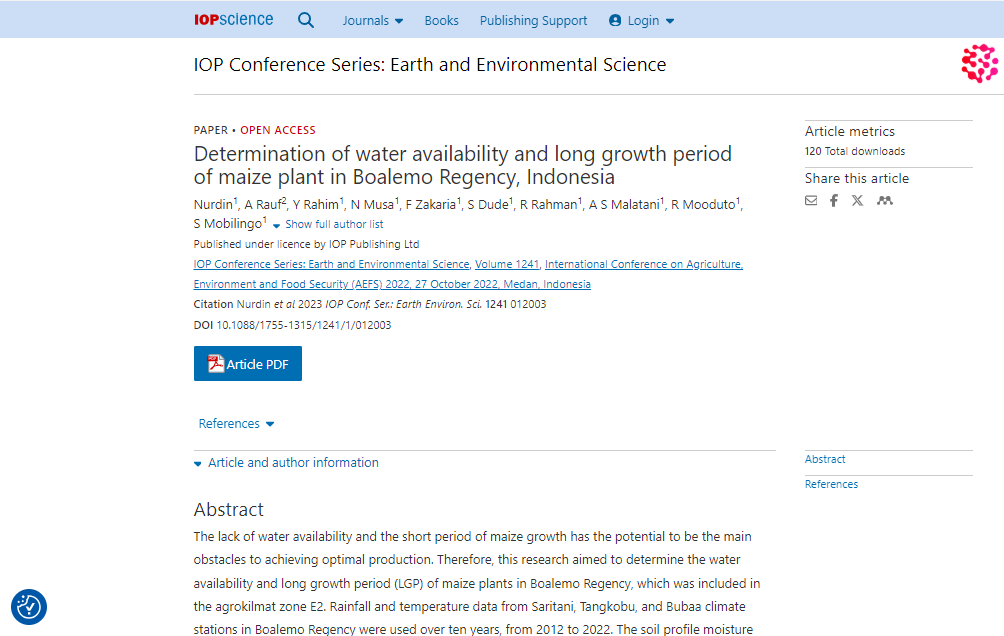Evaluasi Kesesuaian Lahan untuk Tanaman Jagung (Zea mays L.) di Kecamatan Dulupi Kabupaten Boalemo

Agrisaintifika, Vol. 7 No. 2 (2023)
Sinta Mobilingo, Nurdin, Fauzan Zakaria
Universitas Negeri Gorontalo
ABSTRACT
Dulupi is one of the districts in Boalemo Regency which is a center for maize production, but the high intensity of maize cultivation causes a decrease in the quality of the local land. This research aimed to determine the land suitability classes and limiting factor for maize (Zea mays L.). The research was carried out in Dulupi District of Boalemo Regency from September to Desember 2022. It employed a data matching method, matching the data for each land unit with suitability criteria. The findings revealed that the level of the land suitability for maize in Dulupi District, Boalemo Regency had theree classes of land suitability, namely moderately suitable (S2) of 88% (6314,54 Ha), marginally suitable (S3) of 10% (763,89 Ha), and not suitable (N) of 2% (41,15 Ha). In contrast, the yield-limiting factors were nutrient retention, avaible nutriens (N, P, K), erosion hazard, drainage, and effetive depth. With the improvment efforts, the yield limiting factors in the potential land and suitability increased to S2 and S3 classes.
Keywords: Actual, maize, suitability, land, potential
Characteristics and utilization of black soils in Indonesia

SAINS TANAH - Journal of Soil Science and Agroclimatology, Vol 20, No 1 (2023)
Yiyi Sulaeman, Sukarman Sukarman, Risma Neswati, Nurdin Nurdin, Tony Basuki
Abstract
Black soils store a high amount of soil organic carbon (SOC) and play a crucial role in climate change, food security, and land degradation neutrality. However, data and information regarding black soils in tropical regions, including Indonesia, are limited. This study aimed to characterize and identify the utilization of black soils in Indonesia based on legacy soil survey data. We collated 142 soil pedon samples of Mollisols from articles, technical reports, and existing datasets. The site information (site position, elevation, land use type, parent material) and selected physicochemical properties were stored in a spreadsheet, from which exploratory data analysis was conducted. The result showed that the median SOC content was 1.53%, ranging from 0.6 to 8.2 %; cation exchange capacity was 30 cmol kg-1, ranging from 9 to 95 cmol kg-1; base saturation was 87%, ranging from 11 to 100 %; and bulk density was 1.21 g cm-3, ranging from 1.13 to 1.36 g cm-3. Other soil characteristics (particle size distribution, exchangeable bases, pH, pore, and water retention) varied with horizon type and land use/land cover. The black soils have been used for paddy fields, dryland farming, and gardens with low management intensity. Main cultivated crops include rice (Oryza sativa), corn (Zea mays), cassava (Manihot esculenta), sweet potato (Ipomoea batatas), and nutmeg (Myristica fragrans), clove (Syzygium aromaticum), coconut (Cocos nucifera), and cocoa (Theobroma cocoa). Threats to black soil functions include soil erosion, carbon loss, and nutrient imbalance. Soil and water conservation measures, integrated soil nutrient management, and agroforestry are among the best land management practices for black soils.
KeywordsBlack soils; Land use; Mollisols; Soil organic carbon; Soil characteristics
Scopus Q3 dan Sinta 1: https://doi.org/10.20961/stjssa.v20i1.70343
Analysis of degraded land suitability and regional comparative advantages for maize development in the Gorontalo sustainable agriculture areas, Indonesia

Journal of Degraded and Mining Lands Management, Vol. 11 No. 1 (2023)
Mochtar Lutfi Rayes Soil Department, Faculty of Agriculture, Brawijaya Universityhttp://orcid.org/0000-0002-4995-1734
Nurdin Department of Agrotechnology, Universitas Negeri Gorontalohttp://orcid.org/0000-0001-5725-5694
Endang Listyarini Soil Department, Faculty of Agriculture, Brawijaya University
Christanti Agustina Soil Department, Faculty of Agriculture, Brawijaya Universityhttp://orcid.org/0000-0002-0475-1923
Asda Rauf Department of Agribusiness, Universitas Negeri Gorontalohttp://orcid.org/0000-0001-6306-1263
Abstract
Maize has attracted the attention of local governments due to its high yield potential and economic prospects, but the strategic value of this commodity has not been specific to particular locations. Therefore, this study aimed to assess degraded land suitability and determine the regional comparative advantages for maize development in the Gorontalo sustainable agriculture areas. The suitability class was assessed using Automatic Land Evaluation System software, while comparative advantages were determined using input-output and regional analysis. The input-output analysis was based on maize farming data from interviews with 80 farmers. This study also employed location quotient, specialization index, and localization index analyses based on maize, rice, and soybean production data for 2014, 2016, and 2018. The results showed that land degradation caused by soil erosion was dominated by moderate, heavy, and very heavy categories. Most of the actual land suitability for maize was classified as marginal suitable (S3) but became very suitable (S1) and moderately suitable (S2) after the limiting factors were improved. Furthermore, maize was profitable for the land suitability classes of S1, S2, and S3, and the commodity was most concentrated in Mootilango District. Based on the results, land management recommendations followed a pattern of recommendation I > II > III > not recommended.
Keywords:comparative advantagesland suitabilitymaize
Scopus Q3 dan Sinta 1: https://doi.org/10.15243/jdmlm.2023.111.4909
Determination of water availability and long growth period of maize plant in Boalemo Regency, Indonesia

Nurdin1, A Rauf2, Y Rahim1, N Musa1, F Zakaria1, S Dude1, R Rahman1, A S Malatani1, R Mooduto1, S Mobilingo1 and Suryadi1 Hide full author list
Published under licence by IOP Publishing Ltd
IOP Conference Series: Earth and Environmental Science, Volume 1241, International Conference on Agriculture, Environment and Food Security (AEFS) 2022, 27 October 2022, Medan, IndonesiaCitation Nurdin et al 2023 IOP Conf. Ser.: Earth Environ. Sci. 1241 012003DOI 10.1088/1755-1315/1241/1/012003
AbstractThe lack of water availability and the short period of maize growth has the potential to be the main obstacles to achieving optimal production. Therefore, this research aimed to determine the water availability and long growth period (LGP) of maize plants in Boalemo Regency, which was included in the agrokilmat zone E2. Rainfall and temperature data from Saritani, Tangkobu, and Bubaa climate stations in Boalemo Regency were used over ten years, from 2012 to 2022. The soil profile moisture content data used pF 2.5 and pF 4.2 while the tool used Cropwat8.0. Furthermore, the determination of available water and LGP was conducted using a water balance table with the Thornwaite method. The results showed that the highest and lowest water availabilities were 556 mm and 118 mm at the Saritani and Tangkobu climate stations, with a maximum LGP of maize at 242 days and 181 days, respectively. Based on climate stations, the availability of water and the amount of LGP follow the pattern of Saritani climate station > Bubaa climate station > Tangkobu climate station.
Scopus Q4: https://iopscience.iop.org/article/10.1088/1755-1315/1241/1/012003/meta
Determination of Land Suitability Criteria for Maize Hybrid in Boalemo Regency Based on Optimum Yield and Selected Land Quality

Applied and Environmental Soil Science, Volume 2023
Nurdin ,1 Asda Rauf ,2 Yunnita Rahim ,1 Echan Adam ,2 Nikmah Musa ,1Fitriah Suryani Jamin ,1 Suyono Dude ,1 Rival Rahman ,1and Hidayat Arismunandar Katili 3
1Department of Agrotechnology, Universitas Negeri Gorontalo, Gorontalo 96583, Indonesia
2Department of Agribusiness, Universitas Negeri Gorontalo, Gorontalo 96583, Indonesia
3Department of Agrotechnology, Tompotika Luwuk University, Luwuk 94711, Indonesia
Correspondence should be addressed to Nurdin; nurdin@ung.ac.id
Received 22 October 2022; Revised 29 December 2022; Accepted 3 January 2023; Published 18 January 2023
Academic Editor: Maman Turjaman
Copyright © 2023 Nurdin et al. Tis is an open access article distributed under the Creative Commons Attribution License, whichpermits unrestricted use, distribution, and reproduction in any medium, provided the original work is properly cited.
Abstract
The signifcant efect of land quality on maize production has not been fully considered in the existing land suitability criteria.Terefore, this study aims to determine land suitability criteria for hybrid maize in Boalemo Regency based on the optimum yieldand land quality. It was carried out in Boalemo Regency, Indonesia, where the land unit of 67 units was surveyed to obtain landcharacteristics data. A partial least square of structural equation model (PLS-SEM) with SmartPLS 8.0 was used to select a robustland quality controlling hybrid maize yield, while the boundary line method was used to determine optimum yield and differentiating of land suitability criteria. Te result showed that land qualities that defne the optimum yield of hybrid maize wereroot conditions, nutrient availability, nutrient retentions, land preparation, and erosion hazard. Te soil characteristics wereefective depth, coarse material, organic C, total N, K exchangeable, slopes, soil erosion, rock outcrops, and surface rocks.Furthermore, the highest optimum yield of 8.54 ton/ha was achieved by the total N and slopes for a very suitable class (S1), whilethe lowest of 5.58 ton/ha was obtained by exchangeable K for class S1. Tis showed that the combination of PLS-SEM andboundary line analysis was a better approach to developing new land suitability criteria for hybrid maize.
Scopus Q2 dan WoS: https://doi.org/10.1155/2023/3800877
Kategori
- Abstract 2006
- Abstract 2009
- Abstract 2011
- Abstract 2012
- Abstract 2013
- Abstract 2014
- Abstract 2016
- Abstract 2018
- Abstract 2019
- Abstract 2020
- Abstract 2021
- Abstract 2022
- Abstract 2023
- Abstract 2024
- Abstract 2025
- Buku
- Kiprah Tugas Pembantuan ASN-Dosen
- Kunjungan Luar Negeri
- Mata Kuliah
- Pengukuhan Guru Besar, Prof. Dr. Nurdin, SP, MSi
- Project 2009
- Project 2010
- Project 2013
- Project 2018
- Project 2019
- Project 2020
- Project 2021
- Project 2022
- Publikasi Ilmiahku
- Soil Scientist from Gorontalo
Arsip
Blogroll
- a-SintaID
- b-Google Scholar
- c-Scopus ID
- d-Web of Science (WoS) ID
- e-ResearchGate
- f-Academia.edu
- g-SciProfiles
- h-Loop ID
- i-LinkedIn
- j-OrcidID
- k-figshare
- l-Youtube
- m-Twitter
- n-Facebook
- o-Universitas Negeri Gorontalo
- p-BIMA-Kemendikbud RI
- q-FAPERTA UNG
- r-LP2M UNG
- s- LP3M UNG
- t-SIMPPM UNG
- u-SIMLIT UNG
- v-Rispro LPDP
- w-BRIIN
- x-PDDIKTI
- y-GRS BPDPKS
- z-kampusmerdeka
- z1-ANJANI
- z10-SIAT UNG
- z11-Aplikasi SIAGA
- z12-SPADA Indonesia
- z13-SISTER
- z14-tesaurus.kemdikbud
- z15-UKBI
- z16-typoonline
- z17-Turnitin
- z18-Zetero
- z2-eHAKI
- z20-Himpunan Ilmu Tanah Indonesia(HITI)
- z21-BKN
- z21-Kementan RI
- z22-BPS Provinsi Gorontalo
- z23-BPS Kabupaten Boalemo
- z24-BPS Kabupaten Bone Bolango
- z25-BPS Kabupaten Gorontalo
- z26-BPS Kabupaten Gorontalo Utara
- z27-BPS Kabupaten Pohuwato
- z3-Arjuna
- z4-DIKTI
- z5-GARUDA Dikti
- z6-SIM Karier dan SDM Kemendikbud
- z7-KBBI
- z8-Kedaireka
- z9-RAMA
